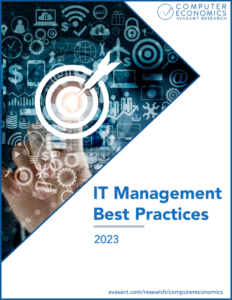IT Management Best Practices – Adoption and Maturity of 35 IT Organizational Disciplines
Much of the mission of the IT organization is to automate and improve business processes throughout the enterprise. But the IT organization itself also has its own need for process improvement and automation. The best-run IT organizations not only focus their process improvement efforts on those of other departments, they also seek to optimize their own IT management processes internally.
In this study, we examine the growth and maturity of 35 IT management practices, which we have grouped into five major categories: IT governance practices, IT financial management practices, IT operational management practices, IT security and risk management practices, and application development practices.
Download or Purchase Now from the Avasant Website
Clients: Download IT Management Best Practices
Not a client? Buy IT Management Best Practices
Want to see more, first? Download sample pages of this report, free.
DETAILED DESCRIPTION
This study, now in its 18th year, is designed to increase awareness of what are best practices in IT management, provide benchmarks for IT leaders to compare their own adoption and maturity levels against other organizations, and justify investments in implementing best practices.
Each year, we ask IT organizations in our annual survey to what extent they are engaged with a selected list of practices. Survey participants have five response choices:
- No activity
- Implementing
- Practicing informally
- Practicing formally but inconsistently
- Practicing formally and consistently
These responses enable us to determine how widely a best practice has been adopted, how formally and consistently it is being practiced, and how quickly it is likely to grow. By comparing current-year responses with those from prior years, we also can assess the growth trajectory of a best practice.
To simplify the presentation, we have grouped the practices into five major categories: IT governance practices, IT financial management practices, IT operational management practices, IT security and risk management practices, and application development practices. While the boundaries between these best-practice categories can overlap, the categories provide an opportunity to discuss the selected practices within the context of related practices. We present our key study findings by category at the beginning of each section.
TABLE OF CONTENTS
IT Management Best Practices
- Introduction
- How We Measure Best-Practices
- Understanding the Best-Practice Profiles
- Major Findings
IT Governance Best-Practice Profiles
- IT Strategic Planning
- IT Project Portfolio Management
- Project Management Office
- Organizational Change Management
- Enterprise Architecture
- IT Vendor Governance
- Cloud Governance
- Data Governance Policies
IT Financial Management Best-Practice Profiles
- IT Personnel Time Tracking
- Service-Based Cost Accounting
- Chargeback of IT Costs
- Showback of IT Costs
- IT Service Catalog
- Benchmarking IT Spending Levels
- Monitoring Software Licenses
IT Operational Management Best-Practice Profiles
- IT Infrastructure Library (ITIL)
- IT Asset Management System
- Bring Your Own Device
- User-Satisfaction Surveys
- IT Performance Metrics
IT Security and Risk Management Best-Practice Profiles
- IT Security Training
- Two-Factor Authentication
- IT Security Compliance Audits
- Penetration Testing
- Security Incident Management
- Encryption
- Disaster Recovery Planning
- Disaster Recovery Plan Testing
- Business Continuity Planning
- Insider Risk Assessment
Application Development Best-Practice Profiles
- Agile Development
- DevOps
- Website Accessibility
- Post-Implementation Audits
APPENDIX
- Benchmarking IT Management Best Practices
- Methodology and Sample

